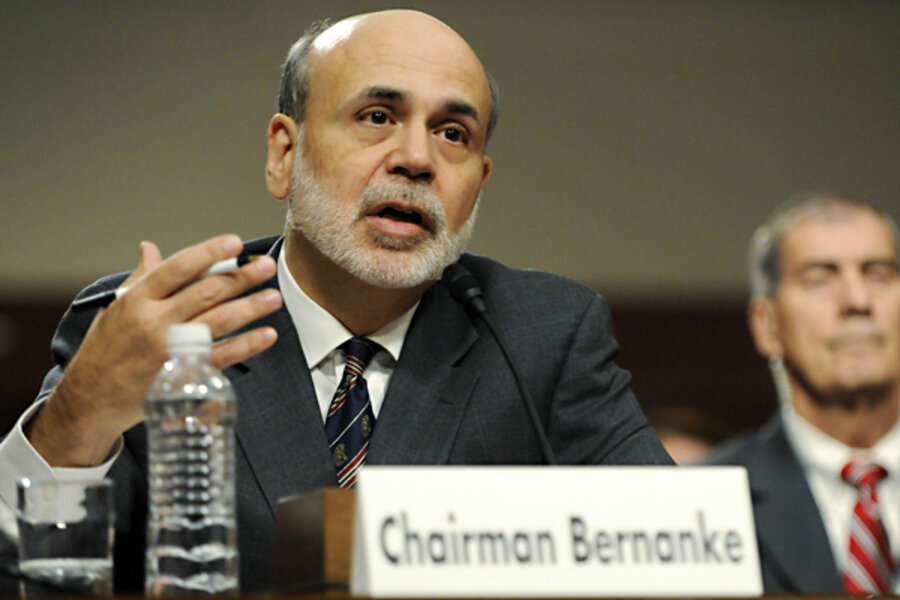Bernanke goes big
Loading...
It would seem we have heard this so many times before that we shouldn’t need to hear it again. The U.S. faces two major economic challenges at the same time: (1) an economy still desperately struggling to get out of (or avoid falling back into) recession; and (2) a fiscal outlook on such an unsustainable longer-term path that it threatens our near-term, and not just longer-term, economic health. The first is mostly a “lack of demand” problem, and the second is more about failing to keep up the supply of productive resources in our economy. The two challenges are very different and might suggest very different policy strategies, but we really can and should address both. We’ve heard this (”we can do both”) principle many times before, but it always helps when someone as prominent as the Chair of the Federal Reserve Board makes it crystal clear in his written and oral (and official) remarks. From Bernanke’s testimony before the Joint Economic Committee (on Tuesday), emphasis added:
To be sure, fiscal policymakers face a complex situation. I would submit that, in setting tax and spending policies for now and the future, policymakers should consider at least four key objectives. One crucial objective is to achieve long-run fiscal sustainability. The federal budget is clearly not on a sustainable path at present. The Joint Select Committee on Deficit Reduction, formed as part of the Budget Control Act, is charged with achieving $1.5 trillion in additional deficit reduction over the next 10 years on top of the spending caps enacted this summer. Accomplishing that goal would be a substantial step; however, more will be needed to achieve fiscal sustainability.
A second important objective is to avoid fiscal actions that could impede the ongoing economic recovery. These first two objectives are certainly not incompatible, as putting in place a credible plan for reducing future deficits over the longer term does not preclude attending to the implications of fiscal choices for the recovery in the near term. Third, fiscal policy should aim to promote long-term growth and economic opportunity. As a nation, we need to think carefully about how federal spending priorities and the design of the tax code affect the productivity and vitality of our economy in the longer term. Fourth, there is evident need to improve the process for making long-term budget decisions, to create greater predictability and clarity, while avoiding disruptions to the financial markets and the economy. In sum, the nation faces difficult and fundamental fiscal choices, which cannot be safely or responsibly postponed.
And don’t just take our monetary policy leader’s word for it. How about listening to Doug Elmendorf, the director of the Congressional Budget Office, which obviously makes him one of our top fiscal policy advisers. From Doug’s testimony before the Joint Select Committee on Deficit Reduction (a.k.a. the “super committee”) on September 13th–again, emphasis added:
There is no inherent contradiction between using fiscal policy to support the economy today, while the unemployment rate is high and many factories and offices are underused, and imposing fiscal restraint several years from now, when output and employment will probably be close to their potential. If policymakers wanted to achieve both a short-term economic boost and medium-term and long-term fiscal sustainability, a combination of policies would be required: changes in taxes and spending that would widen the deficit now but reduce it later in the decade. Such an approach would work best if the future policy changes were sufficiently specific and widely supported so that households, businesses, state and local governments, and participants in the financial markets believed that the future fiscal restraint would truly take effect.
And don’t just take the CBO director’s word for it. How about listening to a mom–i.e., me?! ;) Here’s what I wrote in the Christian Science Monitor last week. I kind of go a little further than either Bernanke or Elmendorf in the argument that you can “do both,” in that I actually believe we could do both at the same time–if only we were willing to make the tougher and better policy choices (i.e., better optimize) in pursuing both our short-term stimulus and longer-term growth goals:
Many policymakers and experts characterize this as long-term versus short-term policy and argue that the short-term spending rise needs to take priority right now.
Actually, both can be pursued at the same time, if Washington is willing to put in place policies that have been proven to work and cut those programs that are less effective.
For the short term, stimulus policies should adhere to the three T’s that President Obama’s former economic adviser Larry Summers first espoused: timely, well-targeted, and temporary. That means policies that as quickly as possible put more money in the hands of the households most likely to immediately spend the money on goods and services, and the businesses most likely to hire more workers…
Over the longer term, deficit reduction can encourage economic growth via higher national saving, while freeing up resources to go to the most productive areas of our economy. Then, instead of having a rising share of resources going toward interest on the national debt or other forms of government spending that provide no public benefits, more funds will get steered toward areas of government spending that our society values highly.
So, you hear a lot of “Go Big” advice to the super committee these days–and even the corollaries to “go long” and “go smart.” But to that we should add to do all those wise things in “both ways,” to address both of the major challenges facing the economy at the same time: we need more jobs, and we need lower deficits.





